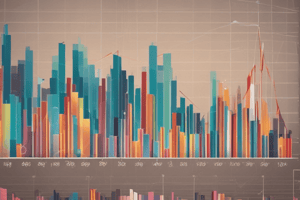Podcast
Questions and Answers
What is the main purpose of a tally chart?
What is the main purpose of a tally chart?
- To calculate statistical measures
- To record and organize primary data (correct)
- To compare different categories of data
- To create visual representations of frequency
What is the purpose of creating a frequency distribution?
What is the purpose of creating a frequency distribution?
- To identify outliers in the data
- To calculate the mean of the data
- To group data into categories (correct)
- To plot data on a graph
How is the frequency of each category determined in a tally chart?
How is the frequency of each category determined in a tally chart?
- By counting the tally marks for each category (correct)
- By calculating the mean of the data
- By using bar graphs
- By finding the mode of the data
Which type of frequency table shows the tally marks for each category, often grouped in fives?
Which type of frequency table shows the tally marks for each category, often grouped in fives?
What is the purpose of using tally marks in a tally chart?
What is the purpose of using tally marks in a tally chart?
How do tally charts and frequency distribution relate to each other?
How do tally charts and frequency distribution relate to each other?
In statistical analysis, what do tally charts help us quickly identify?
In statistical analysis, what do tally charts help us quickly identify?
What is the main benefit of using frequency distribution and tally charts in data analysis?
What is the main benefit of using frequency distribution and tally charts in data analysis?
What type of data is typically recorded and organized using a tally chart?
What type of data is typically recorded and organized using a tally chart?
Why is it important to consider the context and quality of the data when drawing conclusions from frequency distributions?
Why is it important to consider the context and quality of the data when drawing conclusions from frequency distributions?
Flashcards are hidden until you start studying
Study Notes
Statistics: Tally Charts and Frequency Distribution
In the world of statistical analysis, understanding how to display and interpret data is an essential skill. Tally charts and frequency distribution are two foundational tools that help us organize and analyze data in a clear and accessible manner. In this article, we will delve into the concepts of tally charts, frequency distribution, and their relationship to help you gain a deeper understanding of these topics.
Tally Charts
A tally chart is a simple and visual way to record data, making it easy to see the frequency of a certain item or event. It is typically used to record and organize primary data, allowing us to quickly identify which categories or items have the highest occurrence. To create a tally chart, follow these steps:
- Collect the data and sort it into categories.
- Use a tally mark (usually five bars in a group, | | | |) to represent each occurrence of an item or event in a category.
- Count the tally marks to find the frequency of each category.
For example, let's say we are interested in collecting data about the ways students get to school:
| Mode of Transportation | Tally | Frequency |
|---|---|---|
| Bus | ||
| Car | ||
| Bicycle | ||
| Walk | ||
| Other |
As we record the data, we would use tally marks to represent each occurrence of a mode of transportation. To find the frequency, count the tally marks in each row.
Frequency Distribution
Frequency distribution is a statistical concept that describes the distribution of data in a dataset by grouping data into categories or classes, then counting the number of data points that fall into each category. This method allows us to analyze the data in a more structured and organized manner, and it helps us see patterns and trends in the data.
To create a frequency distribution, follow these steps:
- Organize the data into categories or classes.
- Count the number of data points in each category.
- Create a frequency table to show the frequency of each category.
There are several types of frequency tables, including:
- Tally tables: These show the tally marks for each category, and they often group the tally marks in fives (| | | |).
- Frequency tables: These show the frequency of each category without the tally marks.
- Frequency polygons: These are graphs that show the relationship between frequency and class intervals.
Tally Charts and Frequency Distribution: A Connection
Tally charts and frequency distribution are closely related concepts. Tally charts are a practical tool for creating frequency distribution tables, allowing us to quickly count the tally marks and interpret the results. Frequency distribution, on the other hand, provides a theoretical framework for organizing and analyzing data, helping us understand and interpret the results of our tally charts.
By using tally charts and frequency distribution, we can effectively analyze and interpret data, identify patterns and trends, and make informed decisions based on the results. Remember to always be mindful of the limitations of these methods and consider the context and quality of the data when drawing conclusions.
Studying That Suits You
Use AI to generate personalized quizzes and flashcards to suit your learning preferences.




